Welcome back to Week 22 in my weekly reports analyzing the Covid-19 pandemic and its effects on the country and higher education, and welcome to our new subscribers! For those of you reading this on my blog, Off the Silk Road, I have also launched a newsletter, where these reports can be sent directly to your email each week. Click here to subscribe.
Last week, we took a look at the latest college outbreaks and discussed why we must think of colleges as small cities — parallels exist on higher ed and on the national level. This week, we will unpack stunning new revelations in Bob Woodward’s book and examine new college outbreaks as they become the nation’s newest hotspots.
A national look
It’s been six months since the U.S. went into a “lockdown” state in the middle of March. When we look back on half a year, not much has changed. Our testing capacity has declined, and as most antigen tests are not counted, we do not actually know how many people are being tested per day in this country. We still do not have enough N95 masks for our frontline healthcare workers. Top health officials are still being muzzled by the Trump administration.
On Friday, the United States commemorated the 19th anniversary of the September 11 attacks. The U.S. death toll of Covid-19 is 66 times the number of Americans killed by the terrorist attacks. We have become numb to our nation’s collective loss of life during the pandemic. Just as we should never forget those who lost loved ones on September 11, we should never forget the nearly 200,000 Americans who have died from this deadly disease.
As Labor Day has passed, we will monitor the statistics for any spike in cases following the holiday weekend. Currently, the U.S. is still averaging around 40,000 cases and 1,000 deaths per day. Additionally, our nation is facing another crisis: the wildfires on the West Coast. Our thoughts go out to all that are affected by this natural disaster.




On Wednesday, we learned shocking revelations in veteran journalist Bob Woodward’s new book, “Rage.” Through a series of 18 interviews with Trump, we can hear him on tape downplay the severity of the virus and subsequently lie to the American people. “You just breathe the air and that’s how it’s passed,” Trump said in a February 7 call, according to The Washington Post. “And so that’s a very tricky one. That’s a very delicate one. It’s also more deadly than even your strenuous flus.” He continued, saying “This is deadly stuff.”
On March 19, President Trump told Woodward, “I wanted to always play it down. I still like playing it down, because I don’t want to create a panic.”
Let’s unpack all of this. This country is on fire, both figuratively and literally. Here’s what we know.
- The president downplayed the threat of this virus.
- The president admitted that he downplayed the threat of this virus.
- The president told us why he downplayed the threat of this virus.
We always knew that 1. was true — investigations by major news outlets over the spring and the summer revealed this. But 2. and 3. are new. In summary,
- The President of the United States was aware of how deadly Covid-19 was and its severity.
- The president lied to the American people, frequently comparing Covid-19 to the flu.
- The president admitted, in his own words, “I wanted to always play it down,” because he didn’t want to “cause a panic.”
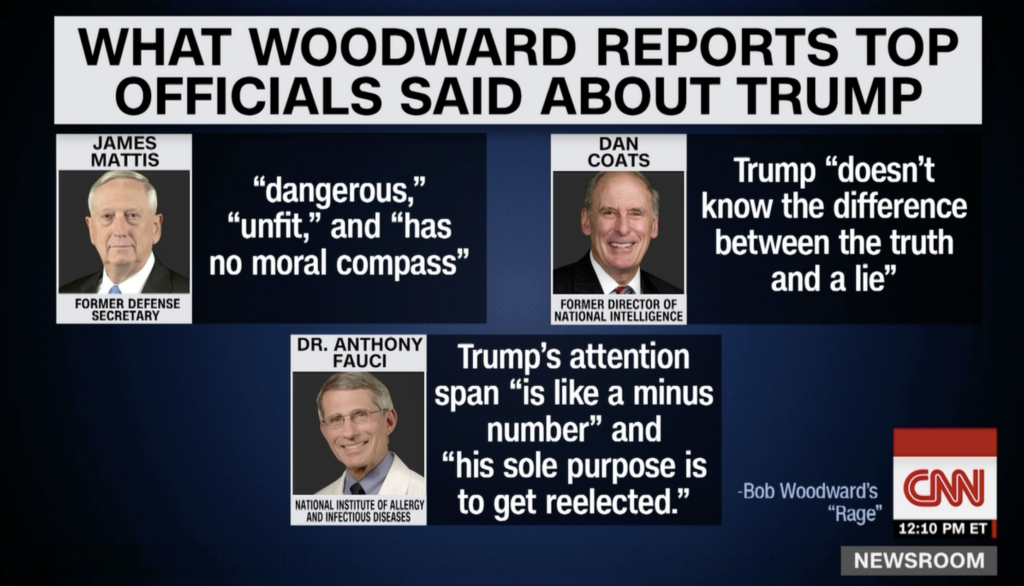
As I wrote in a Twitter thread last week:
“Donald Trump lives in an America where he does not give aid for testing to ‘blue states.’ He lives in an America where hundreds of thousands are dead and millions more are sick. He lives in an America that is not ‘the land of the free.’ It’s the land of the dead.”
One has to go back and think how many lives could have been saved if the American public was made aware of the danger of the disease. Regardless of whether you think Bob Woodward himself should have alerted the American public earlier, you cannot deny the fact that the president knew how deadly this disease was and still continued to hold 17 rallies and other large events since the February 7 channel. This is a war crime — perfectly fitting a so-called “wartime president.”
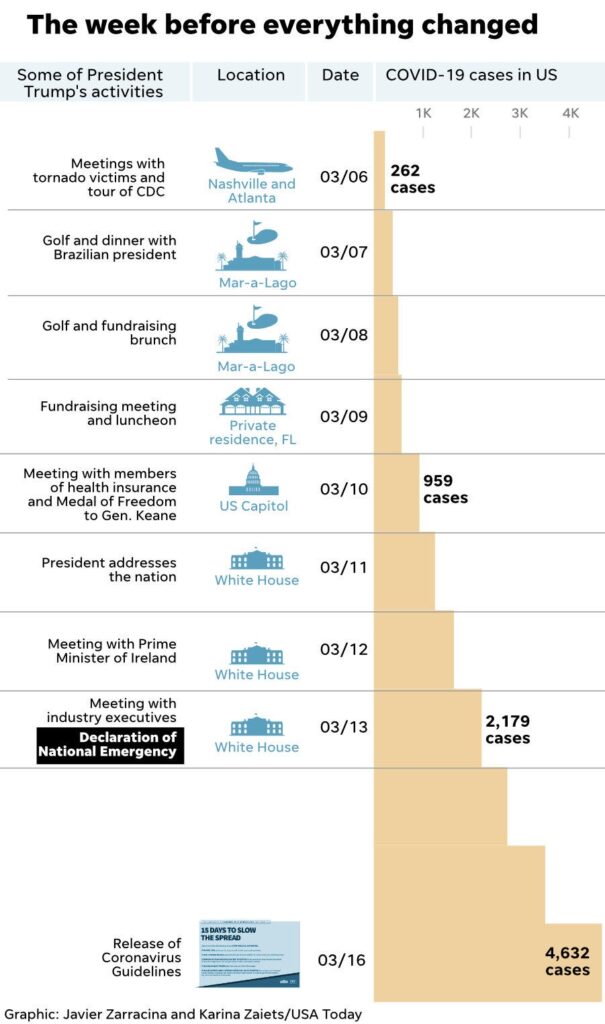
“A U.S. president has deliberately lied about science in a way that was imminently dangerous to human health and directly led to widespread deaths of Americans,” editor in chief of Science Holden Thorp wrote. “This may be the most shameful moment in the history of U.S. science policy.”
Late Friday night, we learned that under Assistant Secretary of Health and Human Services for Public Affairs Michael Caputo, the Trump administration interfered with the CDC’s Morbidity and Mortality Weekly Reports (MMWR), a key element of accurate information on the latest developments in public health. In this newsletter, I have referenced MMWRs multiple times each week. According to Politico, “There have been substantial efforts to align the reports with Trump’s statements, including the president’s claims that fears about the outbreak are overstated, or stop the reports altogether.” Interfering with vital public health communications is a crime at the highest level.
Let’s talk about testing. A new paper from Johns Hopkins researchers shows that testing is a tool, but even our best version (PCR swabs) is imperfect. If our goal is disease control, it’s all about getting people into isolation and quarantine. So, we should be cautious about lowering sensitivity unless we can test more often. This goes along with similar sentiments from professors David Paltiel and Rochelle Walensky arguing for more frequent antigen testing: “Rapid, saliva-based antigen testing is an essential weapon in the fight to resume many of the activities and reopen many of the venues that comprise what we used to call ‘normal life.’”
Meanwhile, the Centers for Medicare & Medicaid Services released for the first time county-level test positivity rates from August 27 to September 2. While the national average is around 7%, one county in South Dakota had a test positivity rate of a whopping 89%. 28% of the nation’s counties are in the “red zone,” with test positivity rates of above 10%, as seen on this map.
Let’s take a look at some of the latest scientific developments:
- A paper published by economists at the University of Denver estimated that 267,000 coronavirus infections from August 2 to September 2 — or one-fifth of newly reported cases in the U.S. during that time — can be traced back to the Sturgis, South Dakota motorcycle rally, with $12 billion in public health costs associated with it. However, scientists and experts such as Dr. Ashish Jha and Dr. Jennifer Dowd said that these case numbers raise issues with the methodology of the paper, since the counties the researchers identified did not actually experience rises in case counts in the weeks following the rally. So was the rally a superspreader event? Probably. Did it contribute to over 250,000 infections nationwide? Probably not.
- The biggest randomized controlled trial of convalescent plasma yet found that in 464 patients in India, there was no difference in composite endpoint of progression to severe disease or all-cause mortality.
- The coronavirus is mutating, as this article in Nature notes, but the mutations are small enough that it does not make a huge difference.
- A paper from researchers at the University of Vermont found that the key factors associated with a higher probability of being Covid-19 positive were the number of contacts with adults and seniors, particularly contacts with people who are themselves Covid-19 positive. The factors that predict contacts, in turn, are working environment, living environment and, disturbingly, regularly wearing a mask outside of work.
- A study in PLOS Biology found that the body’s immune response to Covid-19 is suboptimal and delayed in those over age 60 and in men compared to the general public.
- According to reporting from The New York Times, the coronavirus attacks the brain, causing symptoms like delirium and confusion in some.
- A study from Iceland published in the New England Journal of Medicine found that out of 1,797 tested people who’d recovered from Covid-19, 91.1% produced detectable levels of antibodies. Moreover, these levels had not declined four months after the diagnosis.
- Madrid is experiencing a new surge in cases, possibly due to weak testing and tracing and reopening dining too quickly.
- 4 in 10 adults reported avoiding medical care because of concerns related to Covid-19, according to a new CDC report.
- While we are still learning more about immunity and how it can impact vaccination programs, this diagram published in JAMA Network shows us how bodies typically respond to the virus.
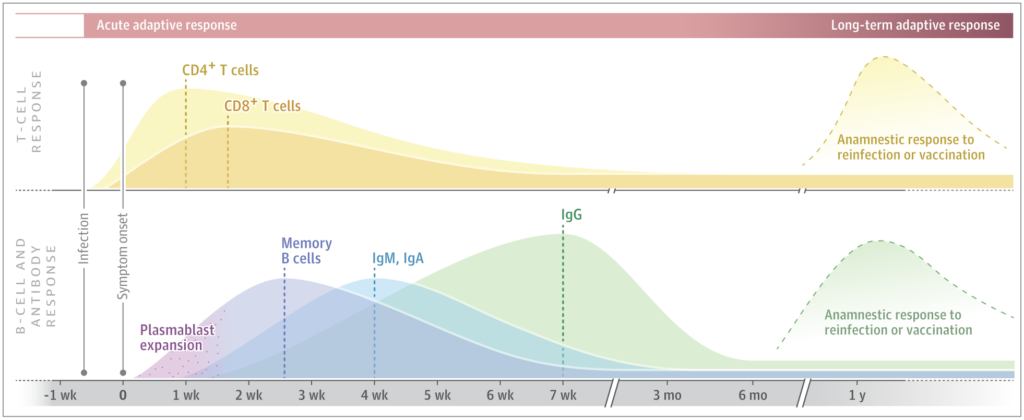
- Of 26 competitive athletes, 4 (15%) had findings suggestive of myocarditis, inflammation of the heart muscle, according to one study. More research is needed to truly understand the effects of Covid-19 on the heart.
- Children can transmit Covid-19 to adults, according to one CDC study of child care centers in Utah. Transmission was documented from these children to at least 12 (26%) of 46 nonfacility contacts (confirmed or probable cases). One parent was hospitalized.
- Eating in a restaurant can put people at increased likelihood for contracting Covid-19, according to one CDC report. Those who tested positive for Covid-19 were more than 2x as likely to have reported going to a restaurant in the previous 2 weeks compared to those who got tested and were negative. It is important to note that the report did not distinguish between indoor and outdoor dining.
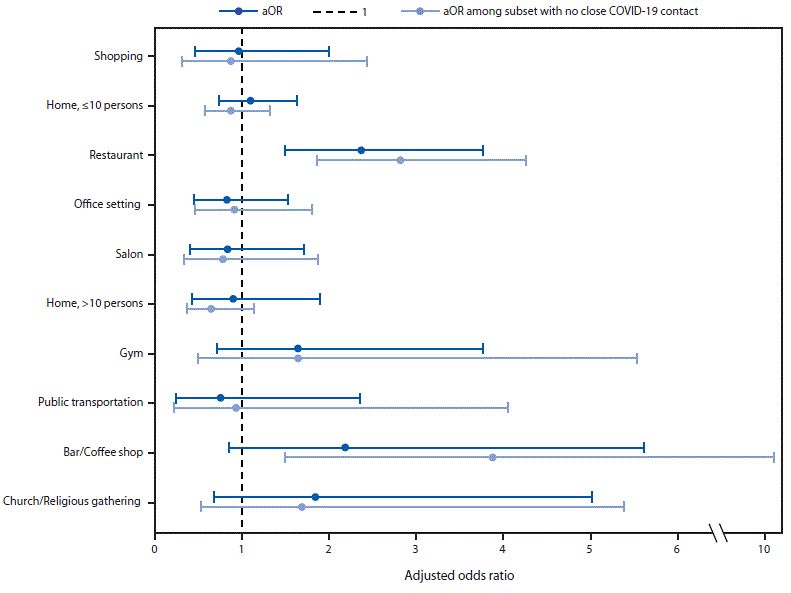
Finally, some updates on vaccines.
- AstraZeneca, one of the major coronavirus vaccine manufacturers, placed their Phase 3 clinical trial on hold due to a suspected adverse reaction in a UK participant. It has since resumed the study in the UK but not in other countries. Stoppages like these are typical and indicate that the safety and efficacy trials are working.
- Pfizer’s CEO said that the company “will have an answer by the end of October” on trial results.
- Russia released the first batch of its vaccine to the public, though many scientists question the reliability of their data.
- According to a Kaiser Family Foundation poll, only 14% of surveyed adults believed a vaccine would be ready before the election, and only 42% would be willing to get a vaccine in that scenario.
- A paper analyzing vaccination by serological prevalence and age group found that a vaccine should be prioritized to adults ages 20-49 years to minimize cumulative incidence and to adults over 60 years to minimize mortality. Distributing a vaccine based on antibody results may improve the efficiency of vaccination efforts.
- A demographic survey by Professor Richard Carpiano at the University of California, Riverside found a large difference in political leanings and willingness to get vaccinated.
As new predictions from the Institute for Health Metrics and Evaluation at the University of Washington show 327,367 deaths predicted by December 1 and 415,090 by January 1, it is clear that this pandemic is far from over. Dr. Anthony Fauci has warned the American public to “hunker down” for the fall and winter and told CNN’s Wolf Blitzer, “If you’re talking about getting back to a degree of normality which resembles where we were prior to Covid, it’s going to be well into 2021, maybe even towards the end of 2021.” The president continuously says that we are “rounding the curve,” and this could not be farther than the truth. As The Wall Street Journal reports, “SARS-CoV-2 is the infectious disease success of the past 100 years.”
This week was America’s week of reckoning. 16 of the largest school districts in the U.S. resumed class this week, and 14 of those were strictly online. The CDC has predicted 25,000 more deaths in the next 21 days, just as Canada recorded zero deaths nationwide on Friday, the first time since March.
The damage the president has done to American public health is immense and will persist in the long-term. Across all party lines, trust in the CDC and Dr. Fauci has been eroded, according to one Kaiser Family Foundation poll. This same poll also showed that 20% of Americans surveyed think that wearing a face mask is not helpful to preventing the spread of Covid-19 and 24% believe that hydroxychloroquine is an effective treatment.
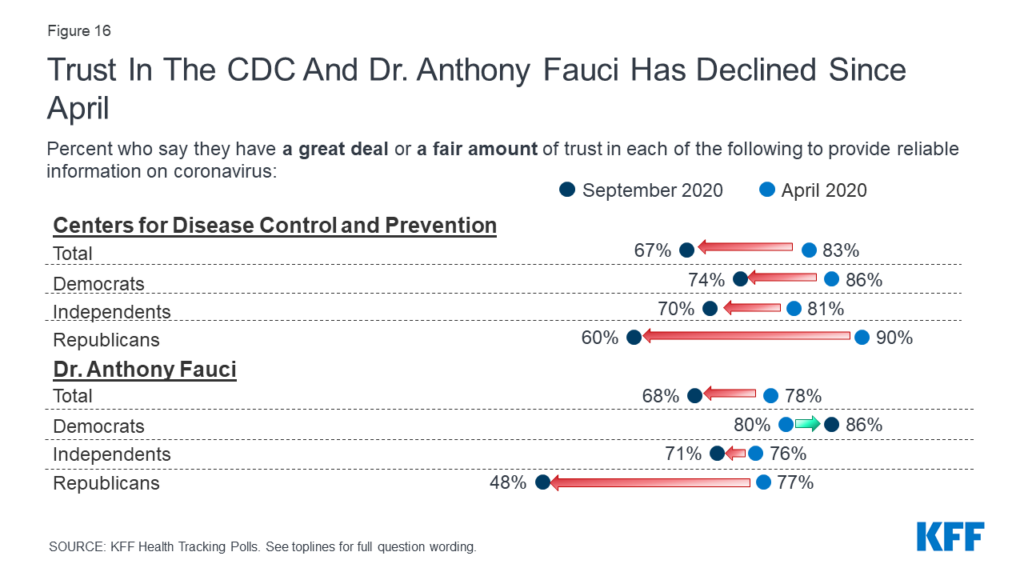
On March 9, the president tweeted, “So last year 37,000 Americans died from the common Flu. It averages between 27,000 and 70,000 per year. Nothing is shut down, life & the economy go on. At this moment there are 546 confirmed cases of CoronaVirus, with 22 deaths. Think about that!” Now, close to 200,000 Americans are dead. Millions more are sick, some with long-term effects. The economy is in shambles. Kids are home from school. Parents are without work. America, ask yourself, “Are you better off today than you were four years ago?”
Let’s move on to our discussion of higher education.
Higher education
College towns are now the new hotspots in this pandemic, as both The New York Times and USA Today have reported: “In just the past week, a New York Times survey has found, American colleges & universities have recorded more than 36,000 additional coronavirus cases.” As some college football resumes and the semester gets underway, these case numbers will only increase.
However, on a day-to-day basis, an analysis of which colleges are experiencing rapid rises in case counts is more useful than a cumulative case count. My college watchlist has been revamped and updated with new thresholds based on the number of new cases in the last 7 days for the 66 colleges I’m currently tracking. When comparing my data to that of the Times, 5% of the colleges the Times has tracked make up 60% of the cumulative cases since the pandemic started. Under my new tracking system, alert levels for colleges can be upgraded or downgraded based on the number of cases the school reports in the last 7 days for which we have data (Green: Less than 30 cases; Yellow: 30-99 cases; Orange: 100-199 cases; Red: 200+ cases). Colleges currently at the top of the list for cases in the last 7 days include the University of Georgia – (1,417), the University of Wisconsin-Madison (1,282), Indiana University-Bloomington (910), the University of Alabama (846) and Ohio State University (773). While many schools struggle with data presentation, including publishing JPEGs of graphs, not labeling values on bar graphs and mixing up quarantine and isolation, this is my best attempt at providing an accurate picture of how the virus is spreading across college campuses.
The good news is that for many schools which experienced outbreaks in late August, their case numbers have declined (though I doubt they are doing enough surveillance testing to detect future outbreaks). I expect us to see “waves” of outbreaks at colleges across the country throughout the fall. One of the schools I am most concerned with is the University of Wisconsin, Madison. While the University switched to remote instruction for the next 2 weeks to limit the virus’ spread, it is possible that we are only at the tip of the iceberg. Take a look at this graph, which shows daily case counts at UNC, Notre Dame, the University of Illinois and the University of Wisconsin. While the higher ed world was shocked with UNC’s numbers, Wisconsin’s are much worse. There have been more cases at the University of Wisconsin-Madison in the last 7 days (1,282) than there have been at colleges across all six states in New England (1,078) since the pandemic began.
Despite our best efforts to track viral spread at colleges based on official statistics reported by individual schools, off-campus living and self-reported cases make it difficult to see infection at some schools. In an effort to solve this issue, I conducted an analysis based on The New York Times’ graph of new daily cases in “college communities” (where undergraduates make up more than 10% of the county’s population).
While this graph is useful for showing the aggregate, it does not show individual county and school trends. This table and map display the counties with the highest rise in new daily cases from August 1 to September 5 and the largest school located in each county.
This analysis seeks to identify one major factor: There are colleges which, due to inadequate testing in their communities, will not report some cases on their own dashboards. This discrepancy between what is officially reported and what is not (due to off-campus living, community spread etc.) will show up in the county-level analysis. Even small increases in county-level data may be enough to detect an increase in cases related to the college. Is this analysis foolproof? Of course not. But it provides a logical framework with which to see outbreaks.
Each week, we take a moment to acknowledge the wacky, stupid and downright dumb elements of colleges’ reopening plans, also known as the College RidicuList.
- Students at the University of Missouri say they were personally blocked by school President Mun Y. Choi on Twitter after complaining about Covid-19 precautions on campus.
- Some parents at the University of Georgia are organizing in a Facebook group to keep the university’s campuses open.
- The county health director in Boone County, where the University of Missouri is located, said that she did not have the authority to force the university to change parts of its reopening plan.
- The families of two students who were dismissed from Northeastern University for engaging in an unsafe gathering at the Westin hotel have hired a lawyer in hopes of fighting the school’s decision.
- The University of Missouri paid a Canadian PR/marketing firm $10,300 to select and run their “campus influencers” program in an effort to promote the university’s Covid-19 guidelines.
- The University of New Hampshire lost 250 student tests on the first day its testing center was in operation.
- The head coach at the University of Oklahoma’s football team said his team will no longer be releasing Covid-19 testing data going forward because of “competitive advantage,” treating test results now as injuries when it comes to public disclosure.
- A group of students at Miami University in Ohio knew they had Covid-19 and hosted a party anyway. The exchange with the police officer is well worth watching.
- Student athletes at some Texas universities are tested three times a week, while most schools do not have adequate testing for their general student bodies.
- UT-Austin required only student ticket holders to test negative for Covid-19 before yesterday’s football game. (Spoiler: The virus spreads among those who do not hold season tickets as well.)
Here are some samples from op-eds and editorials in student newspapers this week, which are always useful for capturing perspectives from students, faculty, staff and local community members.
- “I found out about the positive case in my dorm not from UF Housing or contact tracers, but from a group chat.…currently, UF is endangering its students, staff, faculty and their families,” one student at the University of Florida writes as they advocate for weekly testing.
- “It’s time for a change of course,” editors at Baylor University write. “A number of its students don’t feel safe, and with other students not respecting the science laid out in front of them, it isn’t fair to those who do care to keep the groups together.”
- “As you take the sip of PBR [Pabst Blue Ribbon] or throw that ping pong ball across the table, think to yourself: How much is this party worth?” editors at the University of Vermont ask. “A case of Covid? A life?”
- “[The university] did not genuinely give us the opportunity to weigh in on decisions that deeply impact the campus community and disproportionately affect Black and Brown students,” minority communities at the University of Michigan write as they call for the school to end its student ambassador program, a community policing effort for Covid-19 behaviors.
- “The University of Wisconsin-Madison has already lost its fight against Covid-19,” editors at its student newspaper write. “We lost it because of our administration’s inexplicable insistence that it was a fight we could win, that the fight was worth the risk at all.”
- An anonymous college PR director asks The New York Times’ ethics columnist if it’s unethical to keep telling the public that reopening is safe. “I believe that the institution is placing financial concerns ahead of students’ and employees’ health and safety.”
- The student newspaper at Indiana University chose to put their editorial on the front page and in a very striking layout.
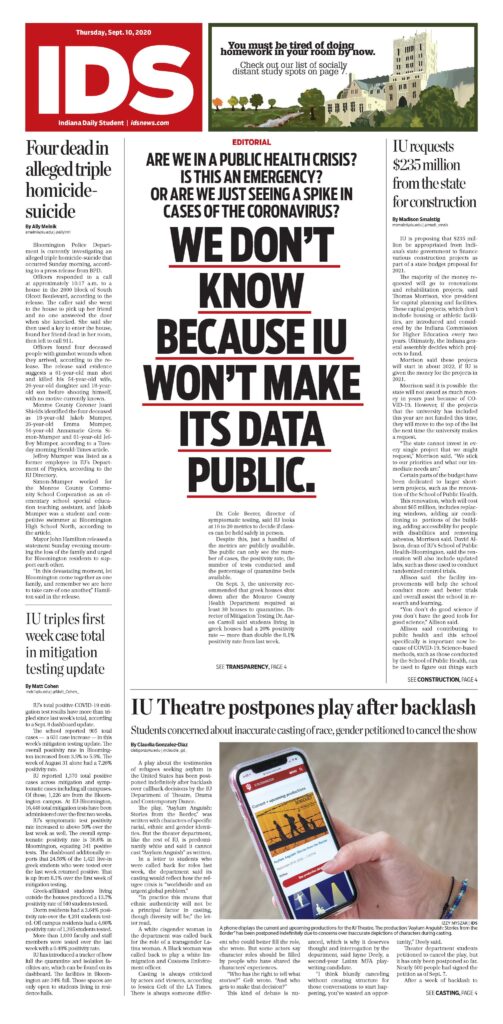
Our focus over the last few weeks has shifted away from college athletics. However, as football season resumes for some, it is vital to consider the dangers of packing thousands of people in a stadium. A Sports Illustrated analysis found a correlation between a school’s allowed stadium attendance and community spread of Covid-19.
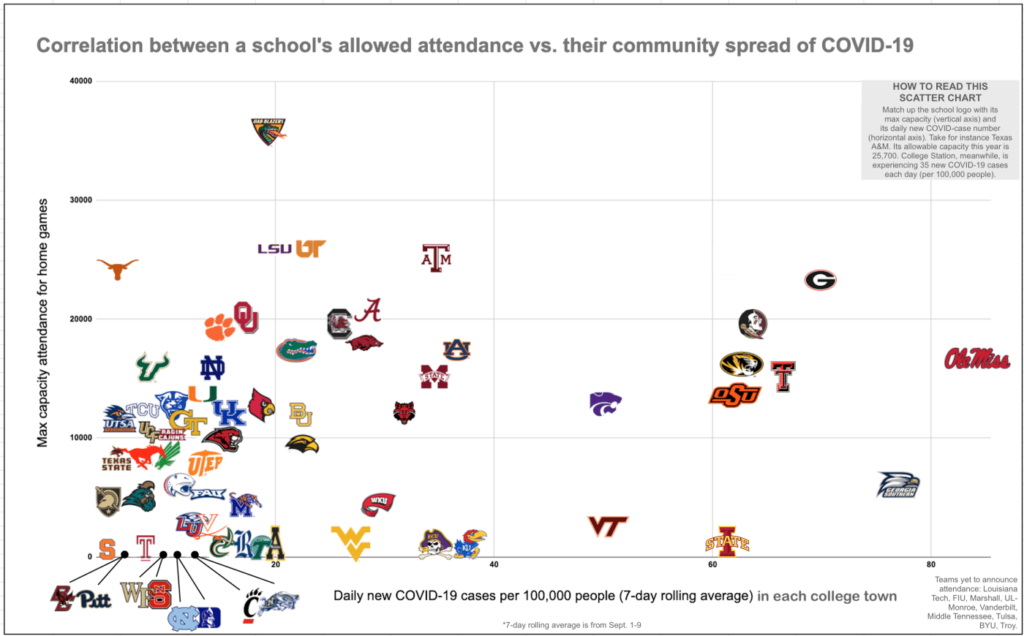
Finally, here is a brief roundup of other college news this week:
- Schools have already started announcing plans for the spring, including the University of Connecticut and Penn State.
- In addition to dividing the community, dismissing students for Covid-19-related violations can also harm students’ trust in the university, critical for cooperation in contact tracing.
- “Many athletes are being tested three times a week or more while their dorm neighbors can potentially go from move-in until finals without getting a single cotton swab stuck up their nose,” The Wall Street Journal’s Laine Higgins writes.
- The Atlantic published a piece on “surveillance theater,” summarizing various technologies colleges have used to monitor student behavior. “Instead of extensive but ineffective surveillance of the inevitable gatherings, universities should offer safer options for socializing (outdoors, distanced) throughout the semester.”
- Some colleges have resorted to policing strategies in order to control student behavior. Harvard epidemiologist Julia Marcus wrote an article in The Atlantic in August about societal policing, which I feel bears particular relevance to today: “Policing won’t help Americans persevere during this ordeal; compassion and creativity will. Indoor gatherings are not advisable during a pandemic, but scolding and retribution will only impede public-health efforts. If officials want to help people avoid the potential harms of parties, they need to earn the public’s trust as partners who offer scientific and practical advice on how to sustain well-being in a pandemic—not as law enforcers from whom the public will want to hide.”
- I joined colleague Lydia Calitri on her podcast, The Youth Vote, to discuss college reopenings.
- Shipping college students off campus following an outbreak without conducting adequate quarantine is a bad idea, as reported in The Wall Street Journal and The Chronicle of Higher Education.
- Students need more mental health support during the pandemic.
- Graduate students and others at the University of Michigan have been on strike against the administration’s pandemic response.
- I would encourage colleges that are considering advancing through phases of their reopening plans to carefully examine the risks and benefits of moving to the next phase. For example, loosening travel restrictions to allow students go for hikes off campus is low-risk and high-benefit, but allowing them to travel to a nearby city could bring a higher risk and less of a benefit.
We will continue to keep tabs on these issues in the weeks to come.
The Good Stuff
Let’s roll the clips of the good stuff. In my usual tradition, I feature my favorite stories from the week. Here are my Top 12.
- Vermont journalist Garrett Graff talked with a score of “9/11 babies” — college students born after 9/11 — about how their lives have been shaped by today’s world.
- State College, Pennsylvania is usually a huge football town. But without a season opener, the Daily Collegian published a slideshow of the day without football.
- Elementary school students in Vermont welcomed their peers back to school with a “Welcome Wagon.”
- After a summer marked by hot spots, lockdowns and travel restrictions, Labor Day was a last chance to get back on the open road, as seen in this New York Times photo essay.
- The pandemic has changed the way we shop for food.
- After a disturbing piece in The Atlantic that Trump President Donald Trump called American Marines killed in World War I “losers” and “suckers,” CNN anchor Brianna Keilar asks wounded veterans and Gold Star families why they serve.
- A New York Times photographer set off to explore America’s historic Route 66.
- A tourist who took sand from a beach in Italy has been fined more than $1,000.
- Photographers at WBUR, Boston’s NPR affiliate, present six months of the pandemic in Boston on their website.
- In the era of socially-distanced shopping, people seem to wait in line for just about anything.
- It’s been six months. Our sense of time is still broken.
- An editor at the Massachusetts Daily Collegian, the newspaper at the University of Massachusetts, Amherst, interviewed editors on staff in 2001 about covering the September 11 attacks.
Conclusion
Here’s the deal: the magic bullet is not coming. It is highly unlikely that there will be a vaccine by Election Day, much less one that can be distributed to the American people at scale. The “twindemic” of the flu and Covid-19 could be catastrophic (get your flu shot!). Our cases are by no means under control, indicating that the virus is still spreading. Colleges in many ways are contributing to nationwide spread, and for those schools not taking action upon seeing cases on campus, they will be responsible for unnecessary illnesses and deaths. This week’s revelations with Trump and the CDC underscored that this is now an America without a leader. If we do not take action, this virus will continue to spread through our communities and campuses this fall and winter, killing more Americans and sickening countless others. There is still time for us to solve our problems, but time is running out. It is up to us to battle for the soul of America and save lives.
I’d like to thank all the student journalists with whom I have the pleasure of working. In the next weeks and months ahead, they will become vital in chronicling their colleges’ paths forward for the fall and beyond. Support their work by reading it.
My best to all for good health.
Like what you see? Don’t like what you see? Want to see more of something? Want to see less of something? Let me know in the comments. And don’t forget to subscribe to the weekly newsletter!
For more instant updates, follow me on Twitter @bhrenton.


